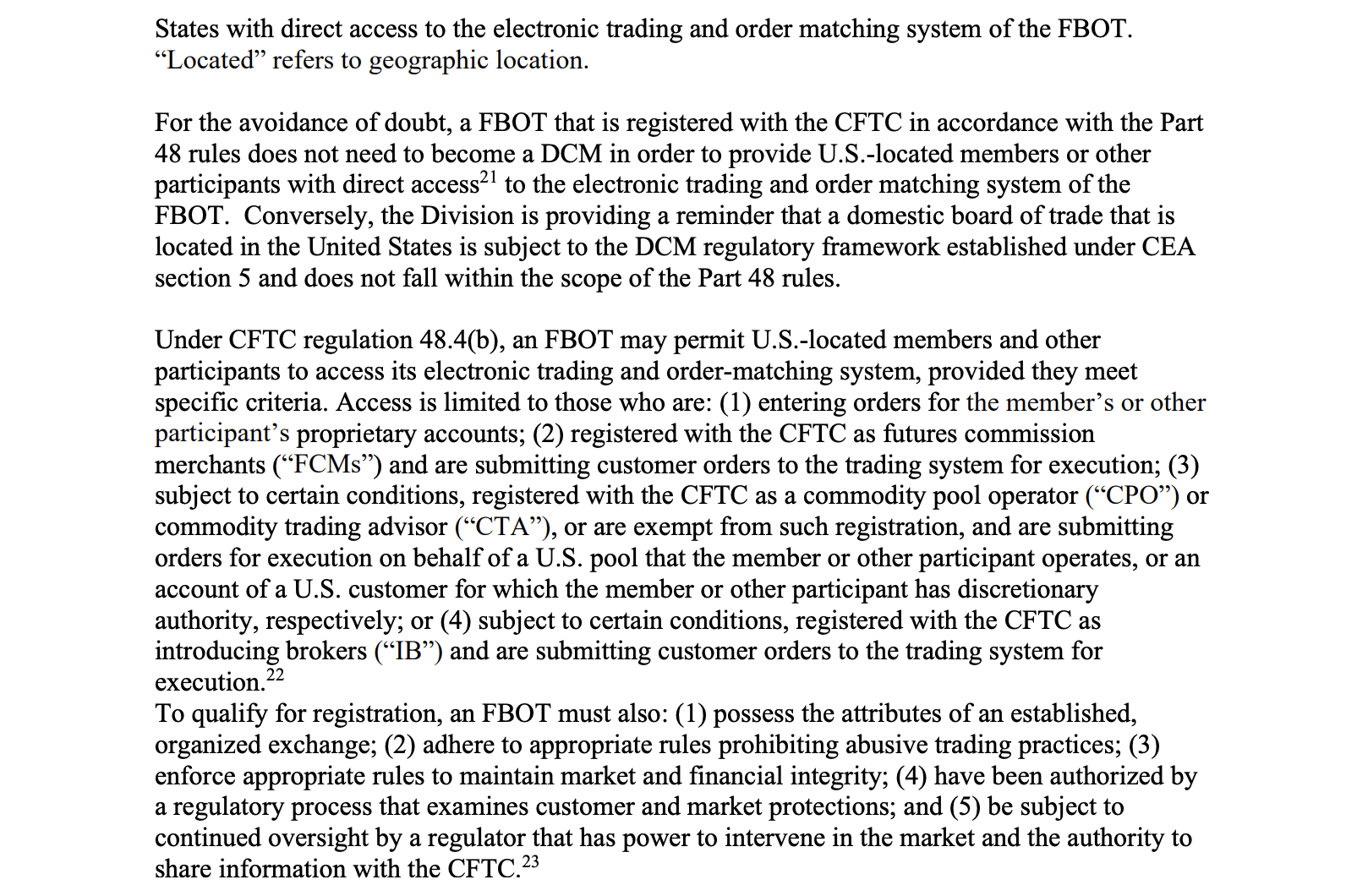CFTC FBOT Guidance May Not Bring Crypto Exchanges Back to US, Centrifuge Counsel Warns
Contents
The FBOT framework is a legacy regulatory route that requires settlement, clearing and licensed futures-commission merchant oversight, making it poorly suited to crypto exchanges. CFTC guidance narrows FBOT eligibility to highly regulated entities, so offshore exchanges are unlikely to return under current rules.
-
FBOT requires legacy settlement and FCM-style oversight, incompatible with most crypto exchanges.
-
Offshore exchanges often operate from unregulated jurisdictions to avoid FBOT-style obligations.
-
Expert: Eli Cohen stresses a legislative crypto market structure bill is the best path to durable clarity.
FBOT framework: CFTC guidance tightens eligibility for offshore exchanges; read expert analysis and next steps for exchanges. Learn what exchanges must do.
What is the FBOT framework and how does it affect crypto exchanges?
FBOT framework is a regulatory pathway that allows foreign boards of trade to serve U.S. customers only if they meet legacy clearing, settlement and licensed-futures intermediary standards. The CFTC’s recent guidance makes FBOT eligibility narrow, meaning most crypto exchanges cannot meet those traditional requirements.
How does the CFTC guidance change FBOT eligibility?
The CFTC guidance specifies that only entities with Licensed Futures Commission Merchant (FCM) capabilities or similarly regulated structures qualify to apply under FBOT rules. That requires comprehensive clearing and settlement systems built for legacy finance, which many crypto-native exchanges do not possess.
The Foreign Board of Trade (FBOT) framework is designed for the legacy financial system and is a poor fit for cryptocurrency exchanges.
The recent Commodity Futures Trading Commission (CFTC) advisory on offshore exchanges serving U.S. residents under the FBOT framework is unlikely to bring most offshore crypto platforms back to the U.S., according to Eli Cohen, general counsel at real-world asset tokenization firm Centrifuge.
Cohen told reporters that settlement, clearing, and other regulatory requirements designed for the traditional financial system, required to serve U.S. clients under the FBOT framework, are not tailored for crypto exchanges and will be difficult or impossible to fulfill.
The CFTC’s guidance also stipulated that only Licensed Futures Commission (FCM) exchanges and other highly regulated entities are qualified to apply under the FBOT framework, Cohen said. He added:
“The main problem is that only regulated exchanges outside the United States can apply for the FBOT. So, you need to have an existing regulatory framework in your home country.”

CFTC staff guidance outlining qualifying criteria to register under the FBOT framework and serve US residents. Source: CFTC
Many exchanges choose to set up businesses in Seychelles or other unregulated jurisdictions to avoid FBOT-style obligations entirely, Cohen noted. Creating a domestic law that codifies crypto rules would provide longer-term clarity than administrative guidance.
Why would a crypto market structure bill help?
Passing a crypto market structure bill in Congress would move rules from agency guidance into statute, creating predictable, durable standards for exchanges, custodians and intermediaries. That reduces regulatory uncertainty that currently incentivizes offshore setups and would allow U.S. policymakers to design crypto-specific settlement and custody rules.
When will the CFTC’s “crypto sprint” deliver clarity?
The CFTC’s “crypto sprint” is an agency initiative aimed at accelerating rulemaking and guidance to support a broader U.S. agenda to lead in crypto. Timelines depend on inter-agency coordination and potential congressional action; agency statements signal near-term guidance but substantive statutory change requires legislation.
How can exchanges respond to FBOT constraints?
Exchanges can take these pragmatic steps to respond to FBOT guidance:
- Assess legal structure: map current operations against FCM and clearing requirements.
- Upgrade infrastructure: implement custody and settlement systems aligned with regulated markets.
- Engage policymakers: advocate for a market structure bill that fits crypto mechanics.
Frequently Asked Questions
Can offshore crypto exchanges register under FBOT to serve U.S. customers?
Only exchanges that meet stringent FCM-style regulatory and clearing criteria can register under FBOT. Most crypto-native exchanges do not have those legacy clearing systems and therefore will struggle to qualify.
Does the CFTC guidance change securities classification for crypto?
The guidance focuses on eligibility for foreign boards of trade and operational requirements; it does not by itself reclassify tokens. Enforcement and classification remain subject to agency jurisdiction and existing securities law interpretations.
What immediate actions should U.S. customers take?
U.S. customers should confirm an exchange’s regulatory status and custody arrangements. Prefer platforms with clear compliance programs or those that support users through regulated intermediaries.
Key Takeaways
- FBOT is legacy-focused: It requires settlement and clearing systems built for traditional finance.
- Most crypto exchanges don’t qualify: The CFTC’s guidance narrows eligibility to highly regulated entities.
- Legislation is the durable fix: A crypto market structure bill would provide long-term clarity and market stability.
Conclusion
The CFTC’s FBOT guidance underscores a mismatch between legacy regulatory frameworks and crypto-native exchange models. Until Congress enacts a crypto market structure bill or agencies design crypto-specific clearing and custody standards, offshore exchanges will likely remain outside U.S. markets. Industry stakeholders should prioritize regulatory engagement and infrastructure upgrades to align with evolving standards.
Comments
Yorumlar
Other Articles
Bitcoin Surges to $93,888: How Venezuela-US Tensions Triggered a Crypto Rally
January 5, 2026 at 07:04 AM UTC
Nokia Eyes AI Telecom Growth with Nvidia’s $1 Billion Partnership
January 1, 2026 at 12:45 PM UTC
CME Raises Silver Futures Margins Again After Extreme Price Swings
January 1, 2026 at 11:47 AM UTC
